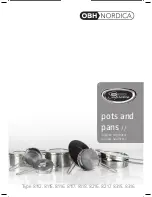
HEATING
Care should be taken to ensure that the heating
installation is correctly installed and that it complies
with all relevant codes of practice. If this appliance
is being connected to an existing system, it is
strongly recommended to check the following.
(a)
That the pipework is adequately insulated
(where applicable).
(b)
Check all controls e.g. pump, radiator
valves etc, are operating satisfactorily and
are compatible with the requirements of the
cooker.
(c)
Cleanse the system and add suitable
inhibitor.
Only competent personnel should be employed to
carry out your heating installation.
PIPE FITTINGS
Materials used for installation work should be fire
resistant, sound and should conform to the current
editions of the following or their equivalent:
1.
Ferrous Materials
B.S. 1387: Steel Tubes
B.S. 4127: Stainless Steel Tubes
B.S. 1740: Steel Pipe Fittings
B. S. 6956: Jointing Materials
2.
Non-Ferrous Materials
EN 29453: Soft Solder Alloys
B.S. 864: Compression Tube Fittings
B.S. 2871 & EN 1057: Copper & Copper
Alloys.
FUELS
The Cooker output levels are assessed on standard
House Coal of good quality. Reduced outputs will
result when fuels of low calorific values are used.
Wood logs up to 21cm long are suitable.
All fuel should be stored under cover and kept as
dry as possible prior to use.
WATER CIRCUIT TEMPERATURE
The return water temperature must be maintained
at not less than 50º C so as to avoid condensation
on the boiler and return piping. Fitting a pipe
thermostat to the return from the gravity circuit and
wiring it into the pump control will ensure than no
cold water will be returned from the central heating
circuit before the water from the gravity circuit has
warmed up the common return pipe and boiler. If
this is not sufficient to keep the boiler temperatures
above the required minimum, a three-way mixing
valve may be fitted to the flow pipe to divert some
CARE FOR YOUR CENTRAL HEATING
SYSTEM
We strongly recommend the use of suitable
corrosion inhibitors and anti-freeze solution in your
heating system, in an effort to minimise black oxide,
sludge and scale build-up, which effects efficiency.
In hard water areas the use of a suitable limescale
preventer / remover is advised.
Use only quantities specified by the water treatment
product manufacturer. Only add to the heating
system after flushing and finally refilling. Refer to
BS 7953.
INJECTOR TEE (Central Heating)
10
Fig.13
Fig.14
hot water straight back into the return. Such a
valve can be operated either manually or
electrically in conjunction with a return pipe
thermostat.
Содержание Mourne
Страница 13: ...12 MOURNE EXPLODED VIEW ...










































